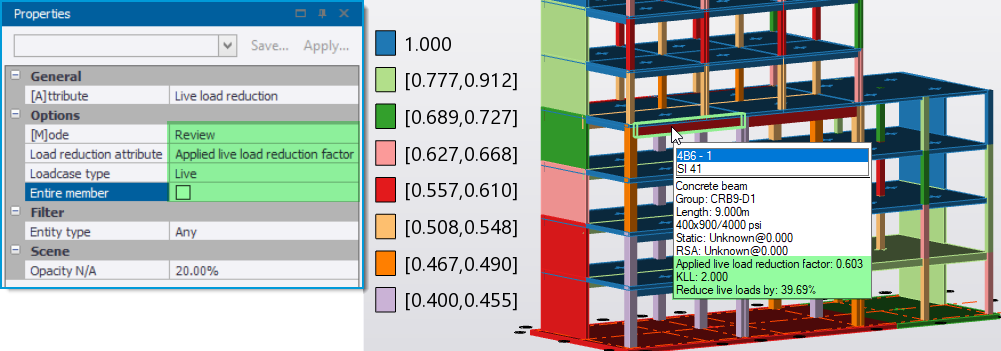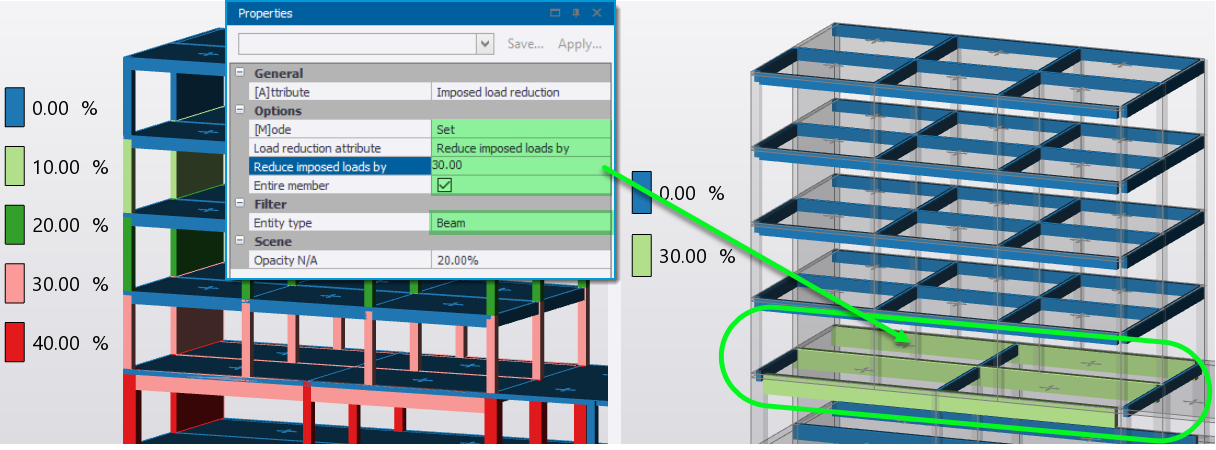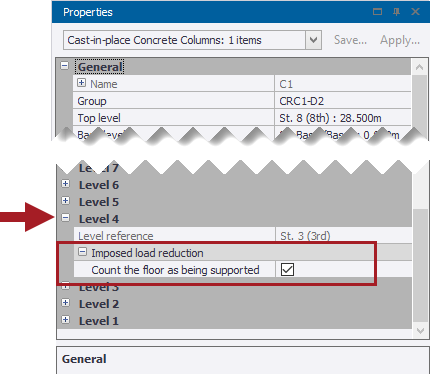Imposed/ Live Load Reductions - Review View Enhancements - All regional codes
Tekla Structural Designer has always featured sophisticated settings and processes to automate the calculation and application of Imposed/ Live Load Reductions where possible*. For more about this see for example the Help Topic Overview of live or imposed load reductions (*Note that reductions are fully within the engineer’s control and only apply when the Imposed/ Live load case(s) are set to have reductions applied as described in this Help topic Activate reductions in live or imposed loadcases. )
The engineer may like to review automatically applied reductions and there are some situations where automatic reduction is not possible and/ or engineering judgment may be required, hence some manual review/ adjustment is necessary. To facilitate this, in Tekla Structural Designer 2022 the Review View > Show Alter state is enhanced with a new dedicated attribute for Imposed/ Live Load Reductions (I/LLR), enabling rapid and efficient graphical review and control of reduction settings and values. This was first introduced in release 2021 SP1.

-
In the above example, the following manual ILR adjustments are made:
-
Transfer beams in the fourth floor - logically these would have at least the same reduction as the columns they support, which themselves support four floors - hence at least 30%. A manual 30% reduction is applied
-
Discontinuous transfer columns - these also support four floors above so logically would have the same reduction as the continuous columns to either side supporting the same number of floors directly. A manual 4 extra floors supported is applied (entire member), producing an automatic 40% reduction for the full height.
-
Transfer Slab in the first floor lower section of the building - logically this would have at least the same reduction as the column it supports, which itself supports three floors - so at least 20%. A manual 20% reduction is applied
-
Mat slabs - following a similar rationale, the panel under the taller section of the building is set to 40% reduction (matching the columns/walls it supports) and under the lower section to 30% reduction.
-
The operation and settings available for Imposed/ Live Load Reductions depend on the model Design Code, which dictates the fundamental method of calculating reductions; by a tributary area approach (USA & Australian regional codes) or by the number of supported floors (other regional codes).
Some key aspects/ differences specific to regional codes are noted briefly below:
-
In common with other attributes, there are two principal modes for the new I/LLR attribute; Review and Set:
-
Review Mode - this allows review of the following I/LLR attributes via automated color coding and legend:
-
Applied live load reduction factor (applicable to all regional codes)
-
Reduce Imposed/ Live load by (applicable to all regional codes) - the reduction factor expressed as a % reduced by e.g. reduction factor of 0.6 = reduced by 40%.
-
Count the floor as supported (applicable to all regional codes except USA and Australia)
-
Number of floors carried (applicable to all regional codes except USA and Australia)
-
KLL value (applicable to USA regional code only)
-
-
Using the Review mode for example for the USA regional code, you can easily review all the automatically calculated reduction factors (from tributary areas) as well as the assigned default KLL factors as illustrated in the pictures below. The tooltip of a selected entity also includes the principal I/LLR data.


-
Set Mode - allows you to graphically edit the I/LLR settings as follows:
-
Reduce imposed loads by - using this you can manually apply specified reduction % values using mouse operations as illustrated in the picture below. As this shows, you can use two adjacent 3D Structure views - one in Review mode and one in Set mode - to simultaneously view the applied reductions as a guide in one while manually making adjustments in the other.
-
With the “Entire member” option enabled, the value is applied to the entirety of continuous entities such as beams, columns and walls. When off it can be applied to individual spans/ stacks/ panels. You can also enable an entity type filter to apply the operation only to beams for example.

-
-
Assume extra floors supported - using this you can manually apply a specified number of extra supported floors as illustrated in the picture below for transfer columns for example. The automatically calculated reductions are then updated accordingly. This control has the same additional “Entire member” and entity filter options.

-
Count the floor as being supported - using this you can manually edit the “Count the floor as being supported” Level property for columns and walls as illustrated in the pictures below. Note that this property defaults to on for all stacks/ panels for all levels set to be a floor that a column/ wall intersects and hence are listed in the column/ wall properties.
-
To change this setting, uncheck the “Count the floor as being supported” option and also the “Entire member” option to edit individual level settings, then click on a column stack/ wall panel to apply. Note the following:
-
Only stacks/ panels with their setting opposite that of the current “Count the floor as being supported” setting in the Attribute Properties can be selected for editing - the cursor tooltip displays the current settings at the upper/ lower ends of a selected stack/ panel for selectable entities.
-
Since the setting applies to the ends of stacks/ panels, it works in a similar manner to editing member end releases using the Fixed/ Pinned Show/ Alter state command; you can click near the end of a stack/ panel to apply the setting only to the level for that end, or in the middle to apply it to the levels at both ends.
-


-
-
KLL - USA regional code only - using this you can manually edit the Live Load reduction factor KLL for entities.
-
- Review and set live load reduction - for the USA
- Review and set imposed load reduction - for other regional codes